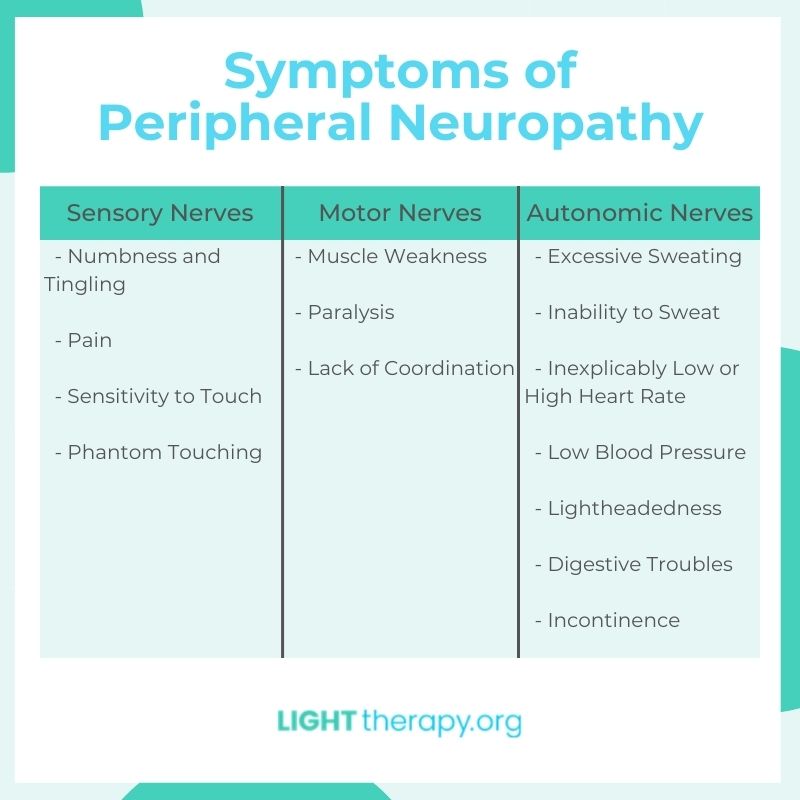Why It’s Early Days for Light Therapy and Peripheral Neuropathy
Light therapy has shown significant promise for many ailments, mental and physical alike. Does light therapy hold promise for peripheral neuropathy? Let’s take a look at what the research says and what the future may hold.
All About Light Therapy
Light therapy is a medical treatment that isolates certain wavelengths of light and shines them onto the body to produce a positive effect. Light-emitting diodes (LEDs) and low-level laser therapy (LLLT) are some of the ways that light therapy can be administered.
Light therapy has traditionally been used to treat seasonal affective disorder (SAD), depression, and sleep disturbances, but it is now being applied to a much wider scope of conditions.
Skin conditions like wrinkles and photodamage are some of the most common, but because light can penetrate beyond the skin’s surface, researchers are studying light therapy for its effects in areas like digestive tract disorders and blood circulation too.
What Is Peripheral Neuropathy?
The word “neuropathy” refers to damage or dysfunction of a nerve. While the central nervous system refers to your brain and spinal cord, the peripheral nervous system includes all the other nerves in your body.
Peripheral neuropathy, then, refers to damage or dysfunction of any nerves outside the brain and spinal cord.
Causes of Peripheral Neuropathy
Peripheral neuropathy has many causes. These can include:
- Diabetes.
- Injury.
- Autoimmune diseases.
- Infections.
- Problems with metabolism.
- Genetic factors.
- Toxin exposure.
- Tumors.
- Alcoholism.
- Certain medications, such as some forms of chemotherapy.
Symptoms of Peripheral Neuropathy
Different nerves operate in different ways in your body. Peripheral neuropathy symptoms will vary based on which nerves are affected.

Peripheral Neuropathy of Sensory Nerves
Sensory nerves process information from your environment, such as pain, touch, and temperature. If your sensory nerves suffer neuropathy, then you may experience symptoms like:
- Numbness and tingling.
- Pain.
- Sensitivity to touch.
- Feeling as if something is touching you when nothing is.
Peripheral Neuropathy of Motor Nerves
Other nerves, called motor nerves, control your muscles and movement. If motor nerves are affected by neuropathy, you may experience:
- Muscle weakness.
- Paralysis.
- Lack of coordination.
Some nerves are responsible for both sensory and motor function. If neuropathy affects these sensorimotor nerves, you will likely experience symptoms of each type.
Peripheral Neuropathy of Autonomic Nerves
Your autonomic nerves handle basic bodily functions that are mostly outside of your conscious control, such as metabolism, blood pressure, sweating, digestion, and urination. Symptoms of autonomic neuropathy can include:
- Excessive sweating.
- Inability to sweat.
- Inexplicably low or high heart rate.
- Low blood pressure.
- Lightheadedness.
- Digestive troubles.
- Bladder or bowel incontinence.
Light Therapy for Peripheral Neuropathy?
We know that light therapy has proven itself helpful for many health conditions. But what about light therapy for peripheral neuropathy? Is there any evidence that it could help?
At this time, the results are mixed.
Evidence Supporting Light Therapy for Peripheral Neuropathy
Many people claim that their peripheral neuropathy was either cured or significantly improved by light therapy. Some physicians also tout light therapy for peripheral neuropathy on their websites, but since they are often selling this very therapy, it’s difficult to rule out bias. Some clinical support, however, is available as well.
One systematic review studied the use of low-level laser therapy (LLLT) for painful diabetic neuropathy. Researchers gathered data from various studies on the subject and assessed three outcomes:
- Pain score.
- Nerve conduction testing.
- Quality of life.
They found that LLLT had a positive effect in controlling pain from diabetic peripheral neuropathy.
An additional study of 40 patients also concluded that deep tissue laser therapy “significantly reduced pain and improved the quality of life in older patients with painful diabetic peripheral neuropathy.”
One trial examined the use of light therapy specifically for chemotherapy-induced peripheral neuropathy. Patients treated for three 30-minute sessions weekly for six weeks experienced a significant drop in neuropathy symptoms. The study also noted that the addition of physiotherapy did not prove more beneficial than light therapy alone.
Another review looked at the use of infrared light therapy for peripheral neuropathy in the feet of 2,239 patients. Researchers found that infrared light treatments reduced the number of numb sites on the feet by 66% and improved pain scores by 67%.
Evidence Against Light Therapy for Peripheral Neuropathy
The majority of research currently available hasn’t identified much of a role of light therapy in treating peripheral neuropathy.
In a 2008 study, 60 patients received either infrared light therapy or a sham light treatment. Participants underwent a variety of pain and nerve conduction assessments to establish a baseline, and then received treatment at home daily, 40 minutes each day for 90 days.
When researchers repeated the assessments after 90 days, they found no significant difference between the two groups.
Another review of other clinical studies assessed whether infrared light therapy could improve pain and plantar (bottom of the foot) sensitivity in people with diabetic peripheral neuropathy.
After examining six studies involving 304 patients collectively, researchers concluded that infrared light therapy did not improve pain. In the studies that included patient follow up, however, researchers noted that the therapy may provide a short-term improvement in plantar sensitivity.
Interested in Light Therapy for Peripheral Neuropathy?
Research on light therapy for peripheral neuropathy is still in its early stages, and more studies will surely become available in the future.
In the meantime, however, light therapy has repeatedly proven itself in clinical trials to be safe and almost entirely free of side effects. So if you’d like to try light therapy for peripheral neuropathy, there’s no reason not to consider it.
You shouldn’t expect miracles, however. And as always, be sure to consult your physician before attempting any new treatment, or if you have questions or concerns.